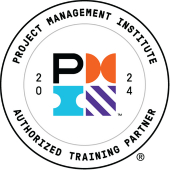Project Management Fundamentals Using Microsoft Project – 3 days, 21 PDUs
Learning Objectives
- To understand the project environment and the impact projects and the project process has on the organization.
- To understand the principles of project management which provide guidance and support in helping the project manager and the project team provide value throughout the project.
- To identify and define the project performance domains that provide structure in supporting the people, processes, and business environment.
- To identify, plan, and manage using multiple project development approaches including predictive, iterative, incremental, and agile/adaptive approaches.
- To allow students to bring a project to class to develop the scope, Microsoft Project schedule and cost baselines following the practices defined in the performance domains.
- To understand the various methods of managing and controlling scope, schedule, cost, quality, resources, communications, procurement, stakeholders, and risks.
Course Overview and Agenda
The objective of Project Management Fundamentals Workshop Using MS Project is to introduce the students to basic project management concepts that can be applied directly to their projects. Using a lecture and exercise format, the students will learn project management following the foundation provided in the Guide to the Project Management Body of Knowledge (PMBOK® Guide) established by the Project Management Institute (PMI). Upon completing the class students will understand and be capable of implementing the primary principles and domains needed to plan and manage and effective project. This class will also allow students to develop actual project management plans and Microsoft Project schedules that can be taken back to their jobs for further planning and execution.
Introduction
- Key Terms and Concepts
- System For Value Delivery (Figure 2-2)
- Information Flow (Figure 2-3)
- Organizational Governance
- Functions Associated With Projects
- The Project Environment
- Internal Environment
- External Environment
- Product Management
-
-
- Sample Product Life Cycle (Figure 2-4)
- Project Management within a Product Life Cycle
- Product Management within a Program
-
-
- Managing Expectations
- Cost of Rework
MS Project Demo: Preparing Preliminary Views and Templates
Project Management Principles
- PMI Code of Conduct
- Be a Diligent, Respectful and Caring Steward (Figure 3-2)
- Create a Collaborative Project Team Environment (Figure 3-3)
- Effectively Engage with Stakeholders (Figure 3-4)
- Focus on Value (Figure 3-5)
- Recognize, Evaluate, and Respond to System Interactions (Figure 3-6)
- Demonstrate Leadership Behaviors (Figure 3-7)
- Tailor Based on Context (Figure 3-8)
- Build Quality into Processes and Deliverables (Figure 3-9)
- Navigate Complexity (Figure 3-10)
- Optimize Risk Responses (Figure 3-11)
- Enhance Adaptability and Resiliency (Figure 3-12)
- Enable Change to Achieve the Envisioned Future State (Figure 3-13)
- Relationship Between Project Management Principles and Project Performance Domains (Figure 1-1)
Exercise: Case Study: Preparing for the FMR Software Implementation Project
Project Performance Domains
- Stakeholder Performance Domain (Figure 2-1)
-
- Definitions
- Examples of Project Stakeholders (Figure 2-2)
- Stakeholder Engagement (Figure 2-3)
- Checking Results (Table 2-2)
- Team Performance Domain (Figure 2-4)
-
- Definitions
- Project Team Management and Leadership
- High Performing Project Teams
- Leadership Skills
-
-
- Establishing and Maintaining Vision
- Critical Thinking
- Motivation
- Interpersonal Skills
-
-
- Tailoring Leadership Styles
- Checking Results (Table 2-3)
- Development Approach and Life Cycle Performance Domains (Figure 2-6)
-
- Definitions
- Development Approaches (Figure 2-8)
- Considerations for Selecting a Development Approach
- Life Cycle and Phase Definitions (Figures 2-9, 2-10, 2-11)
- Delivery Cadence and Development Approach (Table 2-4)
- Checking Results (Table 2-5)
Exercise: Determining the Development Approach for the FMR Software Implementation Project
- Planning Performance Domain (Figure 2-13)
-
- Definitions
- Initiating a Project
-
-
- Develop Project Charter
- Stakeholder Identification
-
-
- Planning a Project
-
-
- Project Management Plan
- Project Product Analysis
- Project Analysis Checklist and Survey (PACS)
- Sample Project Management Plan
- Creating the Scope Baseline
-
-
-
-
- Requirements Solicitation
- Project Scope Statement
- Work Breakdown Structure
- Work Breakdown Structure Dictionary
-
-
Exercise: Creating the Scope Baseline and Summary Tasks in MS Project
-
- Creating the Schedule Baseline
- Primary Dependency Relationship
- Creating the Schedule Baseline
-
-
- Estimating Techniques
- Steps in Creating the Schedule
- Release and Iteration Plan (Figure 2-17)
-
Exercise: Creating the Schedule Baseline in MS Project
-
- Creating the Cost Baseline
-
-
- Cost Budgeting Tools and Techniques
- Budget Buildup (Figure 2-18) – Contingency Reserve and Management Reserve
-
Exercise: Updating the Resource List, Labor Rates and Reporting the Budget at Completion and the Cost Baseline in MS Project. Viewing MS Project Reports.
-
- Creating the Risk Register
-
-
- Plan Risk Management
- Identify Risks
- Perform Qualitative Analysis
- Perform Quantitative Analysis
- Plan Risk Responses
-
Exercise: Creating the Risk Register
-
- Other Plans
-
-
- Change Management Plan
- Quality Management Plan
- Resource Management Plan
- Communications Management Plan
- Procurement Management Plan
- Stakeholder Engagement Plan
-
-
- Checking Results (Table 2-6)
- Project Work Performance Domain (Figure 2-19)
- Definitions
- Maintaining the Process and the Team
- Motivation Theory
- Managing Procurements
- Managing Change
- Managing Project Knowledge
- Checking Results (Table 2-7)
- Delivery Performance Domain (Figure 2-20)
- Definitions
- Delivering Value
- Scope Verification, Validation, and Acceptance
- Schedule Management with Change (Figure 2-21)
- Manage Quality vs. Control Quality
- Cost of Quality
- Cost of Change (Figure 2-22)
- Checking Results (Table 2-8)
- Measurement Performance Domain (Figure 2-23)
- Definitions
- Key Performance Indicators and Effective Metrics
- Measuring Value
- Baseline Performance and Earned Value Analysis and Forecasting
- Resources
- Business Value
- Stakeholders
- Presenting Information/Work Performance Reporting
- Checking Results (Figure 2-9)
Exercise: Updating the Project Schedule and Reporting Status in MS Project
- Uncertainty Performance Domain (Figure 2.32)
- Definitions
- General Uncertainty
- Ambiguity
- Complexity
- Volatility and Risk Audits
- Management and Contingency Reserve
- Checking Results (Figure 2-10)
Tailoring
- Overview
- Why Tailor and What to Tailor
- The Tailoring Process
- Diagnostics
- Summary


